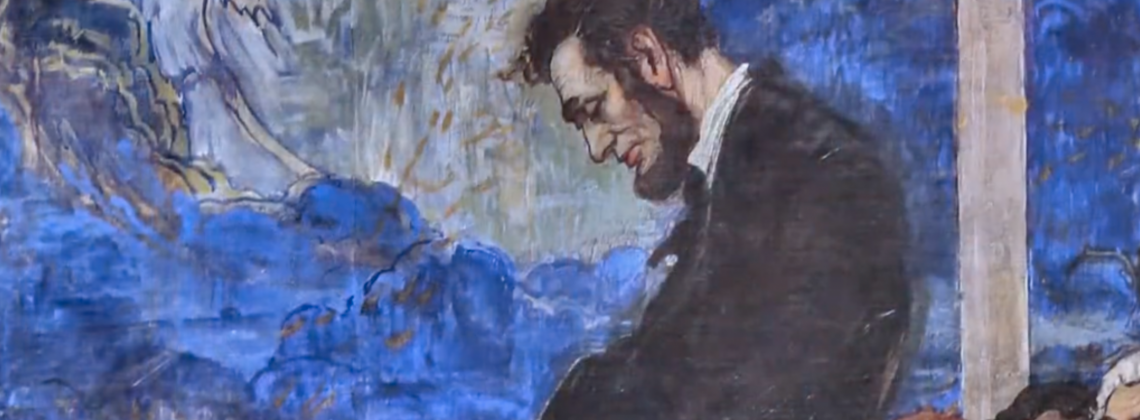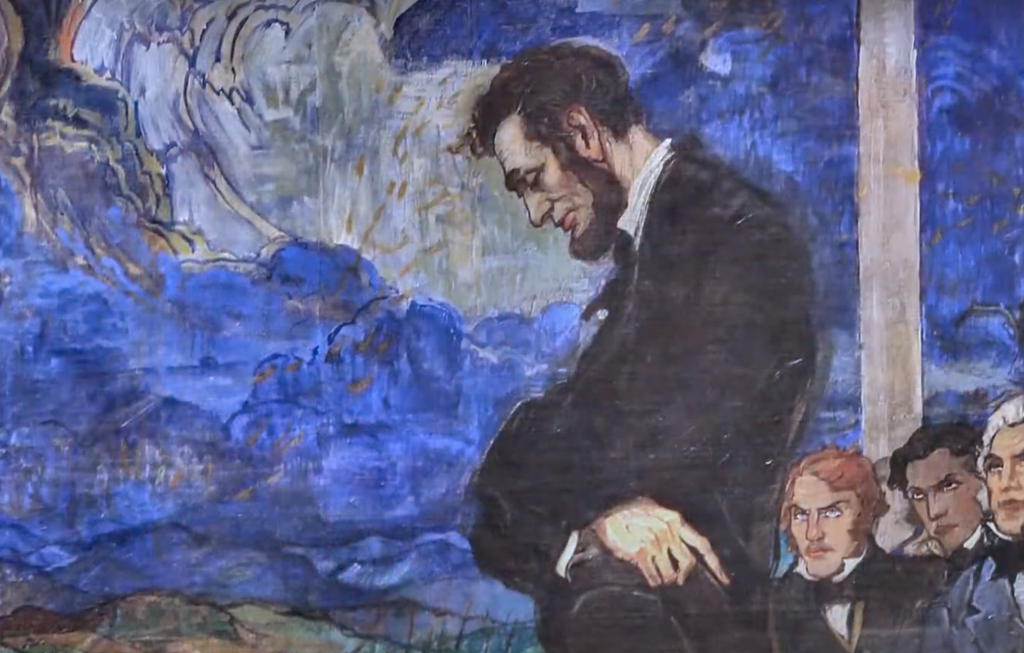

The Pennsylvania GOP gubernatorial candidate’s Christian nationalism on display
Douglas Mastriano, the Republican nominee for governor of Pennsylvania, has faced much criticism for his Christian nationalism—the belief that the United States was founded as a Christian nation and that the purpose of politics is to reclaim this supposed heritage. The criticism is justified. Mastriano is a conservative activist and politician who manipulates the American past to promote his God-and-country agenda.
There is perhaps no clearer example of Mastriano’s Christian nationalist view of American history than a recent video of him giving a tour of the murals in the senate chamber of the Pennsylvania capitol building in Harrisburg. In the video, which was filmed on April 13, 2022 and published earlier this month on Facebook, Mastriano is joined by Abby Abildness, director of the Congressional Prayer Caucus, an organization committed to “igniting an intellectual awakening about prayer and God’s role in America.”
During the tour Mastriano tells us that William Penn’s 1682 prophecy that Pennsylvania would one day be the “seed of a nation” was fulfilled in Philadelphia in 1776 and 1787, perfected in Abraham Lincoln’s Gettysburg Address in 1863, and sustained by Todd Beamer when he said “Let’s Roll” as he helped take down Flight 93 in Somerset County, Pennsylvania on September 11, 2001. Penn’s prophecy, according to Abildness, initiated a spiritual “covenant” between Pennsylvania and God. In her eyes, the real Christian roots of America are not found in John Winthrop’s “city upon a hill” (or “shining city on a hill” as Ronald Reagan said) but rather in a special relationship between God and William Penn’s “holy experiment.”
We also “learn” from the Mastriano and Abildness tour that the covenant between God and Pennsylvania was spiritually transferred to the United States in 1787 when George Washington, as portrayed in one of the capitol murals, presided over the Constitutional Convention in Philadelphia. They tell us that God preserved the life of Washington for this particular moment. Mastriano also “informs” us—contrary to virtually every Franklin scholar on the planet—that Ben Franklin committed his “life to Jesus Christ” before he died. This happened, the gubernatorial candidate says, because Franklin could no longer ignore the providential work of God in the creation of the United States. Finally, we are told that the rising sun on the back of Washington’s chair in the mural is a reference to Isaiah 60:1: “Rise up and shine, for your light has come. The shining greatness of the Lord has risen upon you.”
As a scholar of early American history and an evangelical Christian with two degrees from an evangelical seminary, I must say that there is not enough space in this piece to describe all of the historical and theological problems with what Mastriano and Abildness say in this video. So I will save the rest of my words here to talk about Violet Oakley, the painter who spent decades in the first half of the twentieth century working on these murals.
Oakley was a lesbian Christian Scientist, deeply influenced by Quakerism, who used her art to promote freedom of religion, social justice, and women’s rights. As a globalist she chided the members of Congress for not joining the League of Nations after World War I. She even hoped the United Nations would choose Harrisburg for the site of its headquarters because of the peace convictions and Christian universalism of William Penn.
Oakley’s murals in the senate chamber are filled with images of war, slavery, and peace. Even the most cursory examination of the murals reveals the work of a deeply religious woman whose art, by appealing to the teachings of Jesus and the values of Quakerism, was a way of speaking prophetically to a state and nation that had failed to live up both to its own ideals and to the ideals of the Kingdom of God.
Today, GOP candidates such as Mastriano want to keep this history out of public schools, or at the very least want this history to be presented in a manner that does not make students feel uncomfortable. But as Oakley’s murals make clear, she hoped state legislators and visitors would in fact confront this history. When properly understood, her work should make us feel uncomfortable.
For example, the aforementioned mural of George Washington at the Constitutional Convention includes an image of an African slave boy piling books at the feet of the founding fathers. The fact that the founders are ignoring this boy serves as a piece of social commentary about the failure of the framers to end slavery when they created the Constitution in 1787. Oakley reinforced this interpretation in the next mural. She portrays Abraham Lincoln bowing his head in shame at Gettysburg as the sixteenth president laments the tens of thousands of lives lost in the fight over slavery, an institution the founders failed to abolish.
Like the founders, Mastriano and Abildness ignore the slave boy as they explain the mural. Abildness interprets the mural of Lincoln to mean that God is not done working through the town of Gettysburg. She reminds Mastriano that he is the state senator who currently represents this historic town. The message is clear: Mastriano is God’s anointed one who will rise up from the humble town of Gettysburg to lead the holy commonwealth of Pennsylvania. And as they remind us multiple times in this video, as Pennsylvania goes so goes the nation.
I wonder what Violet Oakley would think about the pro-gun, pro-military, anti-LGBTQ, Big Lie-believing Christian nationalist running for governor of William Penn’s holy experiment and using her artwork to advance his political ambitions.
John Fea is Executive Editor of Current.
Oh my. Thanks.